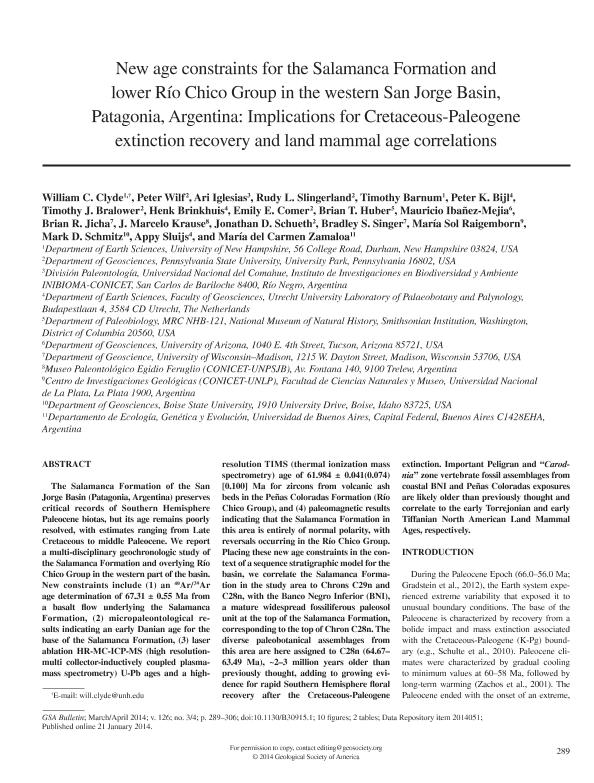Artículo
New age constraints for the Salamanca Formation and lower Río Chico Group in the western San Jorge Basin, Patagonia, Argentina: Implications for cretaceous-paleogene extinction recovery and land mammal age correlations
Clyde, William C.; Wilf, Peter; Iglesias, Ari ; Slingerland, Rudy L.; Barnum, Timothy; Bijl, Peter K.; Bralower, Timothy J.; Brinkhuis, Henk; Comer, Emily E.; Huber, Brian T.; Ibañez Mejia, Mauricio; Jicha, Brian R.; Krause, Javier Marcelo
; Slingerland, Rudy L.; Barnum, Timothy; Bijl, Peter K.; Bralower, Timothy J.; Brinkhuis, Henk; Comer, Emily E.; Huber, Brian T.; Ibañez Mejia, Mauricio; Jicha, Brian R.; Krause, Javier Marcelo ; Schuet, Jonathan D.; Singer, Bradley S.; Raigemborn, María Sol
; Schuet, Jonathan D.; Singer, Bradley S.; Raigemborn, María Sol ; Schmitz, Mark D.; Sluijs, Appy; Zamaloa, María del Carmen
; Schmitz, Mark D.; Sluijs, Appy; Zamaloa, María del Carmen
 ; Slingerland, Rudy L.; Barnum, Timothy; Bijl, Peter K.; Bralower, Timothy J.; Brinkhuis, Henk; Comer, Emily E.; Huber, Brian T.; Ibañez Mejia, Mauricio; Jicha, Brian R.; Krause, Javier Marcelo
; Slingerland, Rudy L.; Barnum, Timothy; Bijl, Peter K.; Bralower, Timothy J.; Brinkhuis, Henk; Comer, Emily E.; Huber, Brian T.; Ibañez Mejia, Mauricio; Jicha, Brian R.; Krause, Javier Marcelo ; Schuet, Jonathan D.; Singer, Bradley S.; Raigemborn, María Sol
; Schuet, Jonathan D.; Singer, Bradley S.; Raigemborn, María Sol ; Schmitz, Mark D.; Sluijs, Appy; Zamaloa, María del Carmen
; Schmitz, Mark D.; Sluijs, Appy; Zamaloa, María del Carmen
Fecha de publicación:
01/2014
Editorial:
Geological Society of America
Revista:
Geological Society of America Bulletin
ISSN:
0016-7606
Idioma:
Inglés
Tipo de recurso:
Artículo publicado
Clasificación temática:
Resumen
The Salamanca Formation of the San Jorge Basin (Patagonia, Argentina) preserves critical records of Southern Hemisphere Paleocene biotas, but its age remains poorly resolved, with estimates ranging from Late Cretaceous to middle Paleocene. We report a multi-disciplinary geochronologic study of the Salamanca Formation and overlying Río Chico Group in the western part of the basin. New constraints include (1) an 40Ar/39Ar age determination of 67.31 ± 0.55 Ma from a basalt flow underlying the Salamanca Formation, (2) micropaleontological results indicating an early Danian age for the base of the Salamanca Formation, (3) laser ablation HR-MC-ICP-MS (high resolutionmulti collector-inductively coupled plasmamass spectrometry) U-Pb ages and a highresolution TIMS (thermal ionization mass spectrometry) age of 61.984 ± 0.041(0.074) [0.100] Ma for zircons from volcanic ash beds in the Peñas Coloradas Formation (Río Chico Group), and (4) paleomagnetic results indicating that the Salamanca Formation in this area is entirely of normal polarity, with reversals occurring in the Río Chico Group. Placing these new age constraints in the context of a sequence stratigraphic model for the basin, we correlate the Salamanca Formation in the study area to Chrons C29n and C28n, with the Banco Negro Inferior (BNI), a mature widespread fossiliferous paleosol unit at the top of the Salamanca Formation, corresponding to the top of Chron C28n. The diverse paleo botanical assemblages from this area are here assigned to C28n (64.67- 63.49 Ma), ̃2-3 million years older than previously thought, adding to growing evidence for rapid Southern Hemisphere floral recovery after the Cretaceous-Paleogene extinction. Important Peligran and "Carodnia" zone vertebrate fossil assemblages from coastal BNI and Peñas Coloradas exposures are likely older than previously thought and correlate to the early Torrejonian and early Tiffanian North American Land Mammal Ages, respectively.
Palabras clave:
Paleogene
,
South America
,
Stratigraphy
,
Fossils
,
Geochronology
,
Paleomagnetism
Archivos asociados
Licencia
Identificadores
Colecciones
Articulos(CIG)
Articulos de CENTRO DE INVEST.GEOLOGICAS (I)
Articulos de CENTRO DE INVEST.GEOLOGICAS (I)
Articulos(INIBIOMA)
Articulos de INST. DE INVEST.EN BIODIVERSIDAD Y MEDIOAMBIENTE
Articulos de INST. DE INVEST.EN BIODIVERSIDAD Y MEDIOAMBIENTE
Articulos(SEDE CENTRAL)
Articulos de SEDE CENTRAL
Articulos de SEDE CENTRAL
Citación
Clyde, William C.; Wilf, Peter; Iglesias, Ari; Slingerland, Rudy L.; Barnum, Timothy; et al.; New age constraints for the Salamanca Formation and lower Río Chico Group in the western San Jorge Basin, Patagonia, Argentina: Implications for cretaceous-paleogene extinction recovery and land mammal age correlations; Geological Society of America; Geological Society of America Bulletin; 126; 3-4; 1-2014; 289-306
Compartir
Altmétricas



